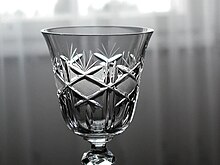

Cut glass or cut-glass is a technique and a style of decorating glass. For some time the style has often been produced by other techniques such as the use of moulding, but the original technique of cutting glass on an abrasive wheel is still used in luxury products. On glassware vessels, the style typically consists of furrowed faces at angles to each other in complicated patterns, while for lighting fixtures, the style consists of flat or curved facets on small hanging pieces, often all over. Historically, cut glass was shaped using "coldwork" techniques of grinding or drilling, applied as a secondary stage to a piece of glass made by conventional processes such as glassblowing.[1]
Today, the glass is often mostly or entirely shaped in the initial process by using a mould (pressed glass), or imitated in clear plastic. Traditional hand-cutting continues, but gives a much more expensive product. Lead glass has long been misleadingly called "crystal" by the industry, evoking the glamour and expense of rock crystal, or carved transparent quartz, and most manufacturers now describe their product as cut crystal glass.
There are two main types of object made using cut glass: firstly drinking glasses and their accompanying decanters and jugs, and secondly chandeliers and other light fittings. Both began to be made using the cut glass style in England around 1730, following the development there of a reliable process for making very clear lead glass with a high refractive index.[2] Cut glass requires relatively thick glass, as the cutting removes much of the depth, and earlier clear glass would mostly have appeared rather cloudy if made thick enough to cut. For both types of object, some pieces are still made in traditional styles, broadly similar to those of the 18th century, but other glassmakers have applied modern design styles.
Expensive drinking glasses had previously mostly concentrated on elegant shapes of extreme thinness. If there was decoration it was mostly either internal, with hollow bubble or coloured spirals within the stem ("twists"),[3] or surface decoration in enamelled glass or glass engraving. Outside Venice and Spain,[4] lighting fittings had not previously made much use of glass in Europe; the enamelled mosque lamp of Islamic art was a different matter.[5] But cut glass "drops", faceted in a style derived from gem cutting in jewellery, refracted and spread the light in way that was new, and were enthusiastically embraced by makers and their customers. The main skeleton of the chandelier was very often metal, but this was often all but hidden by a profusion of faceted glass pieces, held in place by metal wire.
- ^ The best contemporary sources mostly use "cut glass" (especially British ones) as a noun, but often "cut-glass" as an adjective. In the 19th century "cut-glass" as a noun was perhaps more common, as in the first use cited in the OED, from 1845. But Ruskin used "cut glass".
- ^ Osborne, 403
- ^ Osborne, 403
- ^ Osborne, 153
- ^ Osborne, 398–399, 403
